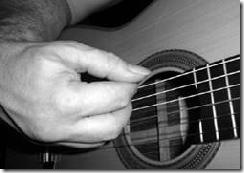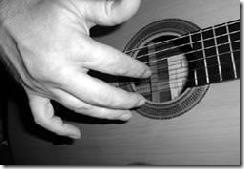Probably one of the most guitaristic effects you can use -- no other instrument can do it, it's a staple of the flamencist's arsenal of sonic weaponry. Do classical artists use it? Sure, you knew that.
The rasgueado is basically a strum pattern that consists of rapid finger strokes of the right hand. The ear is tricked into hearing a lavish, strenuous, lengthy and full arpeggio. The technique is most often executed as a rapid succession of down strokes. The pattern of fingers is ALMOST unimportant though the most natural is to start on the a, then m, then i.
In the following series of photos, you will see my right hand executing one strum in a rasgueado pattern (Boccherini, but that's unimportant.)
In the first photo, my hand is gathered up in what I always describe to myself as a loose fist.. Photo two is about sixty percent through one stroke of the rasgueado. The a finger has completed, the m finger is in mid travel and my i finger has just started.
Like I said earlier, the rasgueado is totally a guitar thing and derives from the flamenco school of technique. As flamenco is a folk style, although richly documented, it still hasn't been accepted by stodgy old classical music circles to the point that it's peculiarities have been codified into notation. Sure, flamencists have their shorthand, but you'll often find a lack of concensus. Most often when you find a rasgueado notated in a piece of guitar music you'll have a little line like a lightning bolt next to a chord and somewhere nearby you'll find rasg. printed.
Long rasgueado passages will often have a rhythmic pattern notated, but the content of each strum is up to the performer to interpret. There are many permutations of finger, string, volume, duration that the guitarist will need to consider -- what is corrrect? Well, unless you know the composer and have that insight, or you are copying the style of one of the master performers, it's up to you as an artist to bring your own flavor to the piece. I've heard guys play piano transcriptions and use a rasgueado to fill in for a large keyboard arpeggio. If the piece is Spanish romantic, well, go to town!
So, we know the how and the why of the rasgueado. Let's put it into performance.
1.) Preparation: Many players plant their thumbs on the sixth string during the majority of their perfromance time (unless it's in use, naturally) and I have seen a rasgueado performed from this starting point. For the most part, rasgueado's are performed across all six strings -- the intent is to be loud and percussive and what better way to accomplish this than to use all six strings? So the first thing one need do is to un-plant that thumb from the sixth string. (Note the thumb in the first of the series of photos.) Keep the right arm loose, you want to drive the strum from the shoulder as well as the fingers. Back to the thumb -- it can be used as a.) a plant to keep an unwanted string from ringing or b.) use it to rasgueado!
2.) Execution: Volume and percussiveness are the key words and you're going to be starting with the weakest finger of the right hand!!! The weight of the forearm helps drive this strum. The shoulder isn't moving in a great arc, but the arm should be free to move up and down, the elbow more so. The fingers brush the strings in turn, first a, then m, then i.
3.) On Accuracy: Guess what? For one time only you are not going to hear me bellyaching about accuracy! Now that your heart has resumed beating -- here is why. What is important here is NOT that each string is plucked or strummed with equal volume, in rhythm, or with perfectly balanced dynamics. No, I'm not saying be sloppy and careless, but think of flamenco as the punk rock of classical music (at least for the guitar player) -- he is there as a percussive instrument, not just to carry a tune or comp chords. This is manly music played with vigor and intensity and your rasgueado should be the same. What you do want to do is be certain that you are getting the result you want and that the rhythms notated in the music are being adhered to













No comments:
Post a Comment